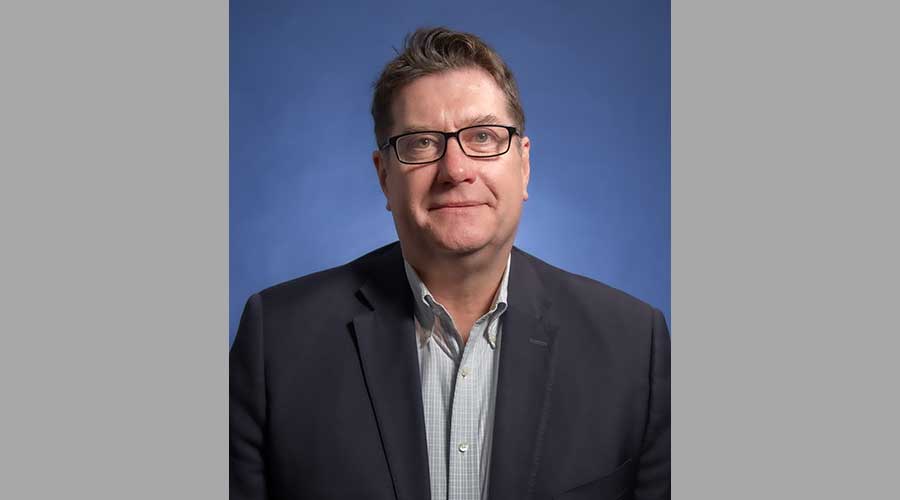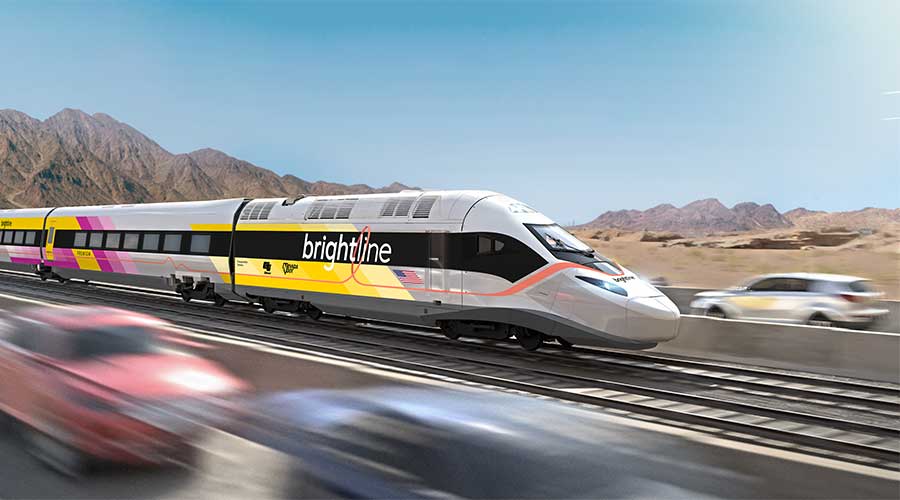Stay updated on news, articles and information for the rail industry
January 2015
Rail News: Passenger Rail
Denver RTD makes the case for a public-private funding approach
— by Angela Cotey, senior associate editor
IT'S BEEN A DECADE since voters approved a four-tenths-of-a-cent sales tax increase to help fund a massive, multibillion-dollar transit expansion project in Denver that includes 122 miles of new light- and commuter-rail lines, 57 new stations and a redeveloped Union Station.
The past decade hasn't exactly played out as Regional Transportation District of Denver (RTD) officials had hoped. The excitement of taking on one of the largest transit expansion programs in the country waned in 2008 when the recession took hold, sales tax revenue plummeted and material costs spiked. By 2011, FasTracks costs had soared to $6.7 billion and RTD officials were faced with a difficult either/or: Ask voters for another sales tax increase or risk not completing the entire program until 2042.
Neither option appealed to RTD execs. The original project timeline called for completing all lines by 2017. Extending the final completion by more than two decades would not sit well with voters, and it would not help address Denver-area mobility issues in the interim. And a secondary ballot measure would have meant funding and carrying out a campaign to garner support for it — not to mention the challenging task of asking for and selling an additional sales tax increase for the same program.
In the end, the RTD staff and board decided to forego a second ballot measure and pursued alternative avenues to make up the program budget deficit. They re-examined financing options, worked with local stakeholders, leveraged relationships with private-sector firms and found new ways to manage debt. Execs also back-burnered some of the smaller projects and devised less expensive, short-term fixes for others.
For the RTD executive and FasTracks project management teams, it's been a long, difficult road as they have navigated the various challenges. They've done so under the watchful eyes of Denver-area voters, elected officials and industry partners who have tuned in — first, to stay up to date on the transportation transformation taking place in Denver, and then to learn how things would play out in light of the recession-related problems.
But it appears as though the FasTracks story will have a happy ending. The majority of the program is set to be completed by 2018, just one year later than initially expected. That's because, despite some speed bumps along the way, RTD officials have found ways to maintain momentum and, as they put it, build as much as they can and as fast as they can, until the projects are completed.
"This is about being flexible, finding a Plan B and having the fortitude to make tough decisions," says RTD General Manager Phillip Washington. "Nobody anticipated the challenges we've had, but I think the question becomes, when you fall down, can you get back up?"
RTD officials believe they have. Despite the financing challenges, two FasTracks components are now completed and five more are under construction. Washington and RTD Chief Financial Officer Terry Howerter attribute the progress to innovative thinking and good timing.
In post-recession 2011, material costs began to decrease and RTD's sales tax revenue began to increase. At the same time, contractors — many of which took a huge business hit during the recession — were anxious to enter into new contracts. RTD officials determined the best course of action to leverage what funds the agency had was to try to garner interest from the private sector.
"We knew we couldn't do all of this just with sales tax revenue," says Washington. "So we could either sit back and point fingers and say why we couldn't get these projects done, or we could go to the private sector, explain our situation and ask them to help."
Public-Private Funding and Unusual Suspects
In September 2011, RTD officials did just that. They held an industry forum in Denver, inviting firms from throughout the United States to participate. About 250 people attended, representing the usual transit players, such as design, engineering and construction firms. Other companies not typically associated with infrastructure projects participated, as well, including representatives from telecommunications and technology firms, and pension funds.
"The Googles of the world, the pension funds of the world, they have capital and are looking for places to use it with a reasonable return," says Washington. "With infrastructure, you build it and you know it's not going anywhere, so if you structure a deal where there's some sort of payback, you do get a pretty good return."
RTD has first-hand knowledge of how a public-private partnership can work in the transit environment. In 2010, the agency entered into an agreement with Denver Transit Partners (DTP) to complete what's known as the Eagle P3 project. The DTP venture is owned by Fluor Enterprises, Uberior Investments and Laing Investments, and also involves a handful of design, engineering, construction and rolling stock firms. DTP was contracted to design, build, finance, operate and maintain the East Rail Line, Gold Line, Northwest Electrified Segment and commuter-rail maintenance facility components of FasTracks. In return, RTD will make service payments to DTP based on the venture's operational and maintenance performance.
During the forum, RTD execs talked openly about the funding challenges they were facing, and expressed their receptiveness to innovative ideas and private participation. They also informed the organizations that weren't familiar with infrastructure investment about the benefits of investing in such projects, with returns realized in the form of user fees, availability payments, tolls and other methods.
None of the "unusual suspects" that attended the forum are helping to finance FasTracks at this point, but just having them on hand to learn about options for infrastructure investment — with RTD, but also for transit projects in general — was beneficial, says Washington.
"They now understand infrastructure, and the challenges facing not just at RTD, but infrastructure in general," he says. "I like to think it's leading to a model in the infrastructure world, this need to bring in the private sector and lay out your projects and constraints so they can fully understand it."
A 'Call For Innovations'
The forum did provide a couple of direct benefits to RTD. After issuing a "call for innovations," the agency received two unsolicited proposals from firms that had ideas to help RTD complete two of its FasTracks lines.
In March 2012, Kiewit Infrastructure Co. submitted a proposal for the I-225 light-rail project. Such proposals often include ideas, called alternative technical concepts (ATCs), that might streamline costs or call for efficiencies not included in the original project, says Washington. RTD determined Kiewit's proposal had merit and issued a request for proposals so other companies could bid on the project.
After receiving one other bid, RTD in July 2012 selected Kiewit's proposal. The team also includes Mass. Electric Construction Co., AECOM and RBC Capital Markets.
The Kiewit team's proposal included ATCs such as realigning a bridge to reduce the length and height of the structure, as well as the length of the retaining walls, and eliminating a traction power substation to help save money.
RTD issued sales tax bonds to help cover the project cost and, thanks to low interest rates, received "very favorable financing," at 3.39 percent of about $546 million, says Howerter.
In 2013, RTD received another unsolicited proposal, this time from a partnership comprising Graham Contracting Ltd., Balfour Beatty Rail Inc. and Harmon Contractors Inc. (GBBH) to design and build the North Metro Line.
In the RFP that followed, RTD asked bidders to submit cost estimates for the project — which initially called for building a rail line from Denver Union Station, through Commerce City and Northglenn, to 162nd Street in Thornton, Colo. — in various segments. That way, agency staff could determine how far out the line could be built using the funds it had available. RTD ultimately selected GBBH to complete the work.
The venture was charged with building the line out to 124th Street that will serve the majority of the ridership base for the corridor. RTD officials hope the line can be extended as more funds become available, possibly before construction is completed on the first phase, says Howerter.
"We didn't have any federal money planned for this corridor, no other financing other than some cash funds pledged toward it, and we were still able to take it out to 124th," he says.
Still Searching For Transit Funding
RTD issued $440.9 million in certificates of participation (COPs) to finance part of the $708 million project, creating a lease arrangement under which RTD will make annual "rent" payments on the certificates until they mature in June 2044. At that time, RTD will assume ownership of all the assets, says Howerter, who likens the financing method to a capital lease arrangement. And, the COPs don't count toward RTD's debt limit for the project.
Other firms working with GBBH include Stantec Consulting Services, Parsons Brinckerhoff, Zann and Associates, Communications Connections Consulting, Transit Safety & Security Solutions and Systems Consulting LLC.
As part of the North Metro bidding process, RTD officials asked interested firms to provide cost estimates for all unfinished portions of FasTracks, even those unrelated to the North Metro corridor. The prices, along with a modest escalation factor, were locked in for two years, and RTD can exercise options on that pricing through December 2015.
"If money falls from heaven tomorrow, we have contractors locked into these prices," says Washington, adding that the costs were low because they were provided during a recession and when material costs had dipped.
The recession provided other financial opportunities for RTD. In 2013, Howerter refinanced three of the agency's outstanding debt deals that saved about $83 million over the life of the loans, he says. By doing so, RTD freed up debt capacity for other FasTracks projects.
By seeking alternative financing solutions and leveraging the funding available, RTD will end up completing the majority of the FasTracks program on time and within budget. But that doesn't mean RTD's expansion challenges are over. Agency execs still are working to launch, revise or find funding for several FasTracks components.
RTD is advancing plans for the Southeast rail extension, which calls for extending the existing 19.1-mile light-rail line to Lone Tree. The Federal Transit Administration accepted the project into the New Starts grant development phase in 2013. RTD is almost finished with the project development phase of the federal funding process and is preparing to submit the project's entry into the engineering phase.
Agency officials hope to obtain a $92 million federal grant for the $207 million project. Local stakeholders, including the city of Longtree and Douglas County, have agreed to contribute about $40 million in cash or right of way for the project, leaving the agency to provide only $68 million for the line, says Howerter.
RTD officials also are working with communities northwest of Denver to determine how they can make near-term mobility improvements after costs to build a 41-mile commuter-rail line from Denver to Longmont skyrocketed.
While the agency still plans to build the line, it won't be able to complete the project anytime soon. In the meantime, RTD is implementing a series of smaller fixes to help address traffic congestion. For starters, RTD is building the first 6.2 miles of the Northwest Rail Line from Union Station to Westminster as part of the Eagle P3 project. It's scheduled to be completed in 2016.
The agency also is working to advance two arterial bus rapid transit (BRT) lines identified in a Northwest Area Mobility Study — conducted by RTD with northwest governments and transportation partners — released last summer.
The BRT corridors will be implemented on two highways that feed out of Longmont, one operating to Boulder and the other to the north metro area. Meanwhile, RTD will annually evaluate strategies to accelerate the project's rail portion.
RTD also is working to advance preliminary work on the Central Rail extension; the agency hopes that funding eventually will become available.
The project would extend an existing light-rail system from the 30th/Downing Station to the East Rail Line's 38th/Blake Station to provide northeast neighborhoods with more direct rail access to the East Rail Line. RTD recently completed a mobility study that identified both a short- and long-term recommendation for completing the project.
The next several years will be crucial as RTD execs gear up to open five new rail lines and make progress on the remaining FasTracks components. They'll do so under a microscope; other transit agencies and federal partners will continue to keep a close eye on RTD's progress to see how the various public-private partnerships and financing mechanisms play out.
RTD officials understand the interest. They are executing one of the country's largest transit expansion programs in recent decades during one of the country's harshest recessions in history, and their ability to keep the majority of the program in tact and on schedule has garnered national attention. They don't mind. RTD has hosted numerous transit and other infrastructure industry executives at its agency to learn about the project and its private financing. They have developed a "lessons learned" document and are putting together a "best practices" manual that includes a section on finance.
That's because RTD execs believe their inclusion of private dollars for public transit projects is not only replicable, but necessary for mega-transit projects going forward. With long-term federal infrastructure funding always uncertain, and state and local funding always limited, private funds are becoming increasingly important, says Washington. And they're available for the right projects.
"The private sector is looking for infrastructure investment — all over the country," says Washington. "We're seeing that now. I think [RTD] just realized it a little bit sooner than other industry partners."
FasTracks Projects — an update
|
DENVER UNION STATION Opened in May 2014, integrating rail, bus, MallRide, MetroRide, Amtrak, taxis and shuttles, and bicycle and pedestrian traffic. WEST RAIL LINE A 12.1-mile, 12-station light-rail corridor connecting Denver, Lakewood and Golden; opened in April 2013. EAST RAIL LINE A 22.8-mile, six-station electric commuter-rail line that will connect Denver Union Station with Denver International Airport; scheduled to open in 2016. GOLD LINE An 11.2-mile electric commuter-rail line that will feature seven stations and connect Denver with Wheat Ridge; scheduled to open in 2016. I-225 RAIL LINE A 10.5-mile, eight-station light-rail line that will connect Aurora to the East and Southeast rail lines; scheduled to open in 2016. NORTH METRO RAIL LINE An 18.5-mile electric commuter-rail line with eight stations connecting Denver, Commerce City, Thornton and Northglenn; RTD currently is building 12.5 miles of the line, as well as six stations, which are scheduled to open in 2018. |
NORTHWEST RAIL LINE A proposed 41-mile, seven-station electric commuter-rail line that will eventually connect Denver, Westminster, Broomfield, Louisville, Boulder and Longmont. RTD is building the first 6.2 miles of the line now, scheduled to open in 2016, and will add bus rapid transit service in the region while it seeks funding to complete the rail corridor. CENTRAL RAIL EXTENSION A 0.8-mile, two-station light-rail extension that will connect downtown Denver with the East Rail Line; construction timeline not yet determined. SOUTHEAST RAIL EXTENSION A 2.3-mile light-rail extension that will connect Denver and Lone Tree, including three new stations; construction timeline not yet determined. SOUTHWEST RAIL EXTENSION A 2.5-mile light-rail extension that will operate between Denver and Highlands Ranch; construction timeline not yet determined. Source: Denver RTD |



 2025 MOW Spending Report: Passenger-rail programs
2025 MOW Spending Report: Passenger-rail programs
 Gardner steps down as Amtrak CEO
Gardner steps down as Amtrak CEO
 Guest comment: Oliver Wyman’s David Hunt
Guest comment: Oliver Wyman’s David Hunt
 Women of Influence in Rail eBook
Women of Influence in Rail eBook
 railPrime
railPrime







